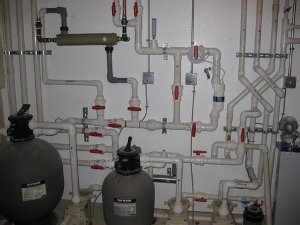Pool Plumbing Systems
The basic configuration of a swimming pool plumbing and filtration system is simple. Water is pulled through the skimmer and main drains in the swimming pool by the pool pump. the water travels underground back to the mechanical room where it passes through the pump strainer basket and is then pushed through the filter and heater as well as any other peripherals such as chlorinators, and is eventually piped back to the pool through the return lines.
Older pools are a breeze as most of them only have three plumbing lines. This configuration would usually have one line from the skimmer and one from the main drain going to the pump and a single return line branching out back to the pool. Some systems only have two pipes as the main drain and skimmer sometimes get tied together.

New swimming pool systems do not look anything like this anymore. With so many options and additional systems such as solar heaters, salt water chlorinators, ozone generators not to mention water falls, hot tubs and water features, new pool mechanical rooms can be pretty intimidating. This is even more true if your pump room is located below grade where opening the wrong valve could drain your pool into the pump room!
In addition to these closed system lines, there are also a few additional aspects to the swimming pool plumbing system which do not operate in a closed (pressurized) system. Most swimming pools employ an open system (gravity fed, not pressurized) equalizer line that helps the pool pump to retain its prime during periods of low water level. This equalizer line is often forgotten about or ignored during renovations as replacing the line is a costly and time consuming enterprise.
The equalizer line will connect to the bottom of the skimmer and the other end to either the main drains, or a side port in the wall of the pool near to the location of the skimmer. It is the pipe that leads from the bottom of the skimmer down to the main drains that is often overlooked.
Since this is a non pressure line it would tend to leak less than a pressurized line, but on average this pipe can also be older than the rest of your pool plumbing system increasing it as a candidate for unexplained water loss.
Plumbing systems are a constant source for water loss for a host of different reasons ranging from pipe material, installation quality, age, configuration and soil conditions. Before you begin to tear apart your plumbing system you need to first isolate the leak to be located in the plumbing system, or in the structure of the pool itself.
To begin diagnosing the location of the leak in your swimming pool proceed to the hydrostatic leak test. You can also choose to stay on the current subject a little longer and read what an industry expert has to say about pool plumbing leaks
The menu on the right is a chronological step by step process to determine where a swimming pool is leaking. This website is written as a readthrough technical assistance guide for locating leaks. When you believe you have identified where the pool is leaking you need to go to our sister website to see pictures and learn more about the actual swimming pool leak repair process.
